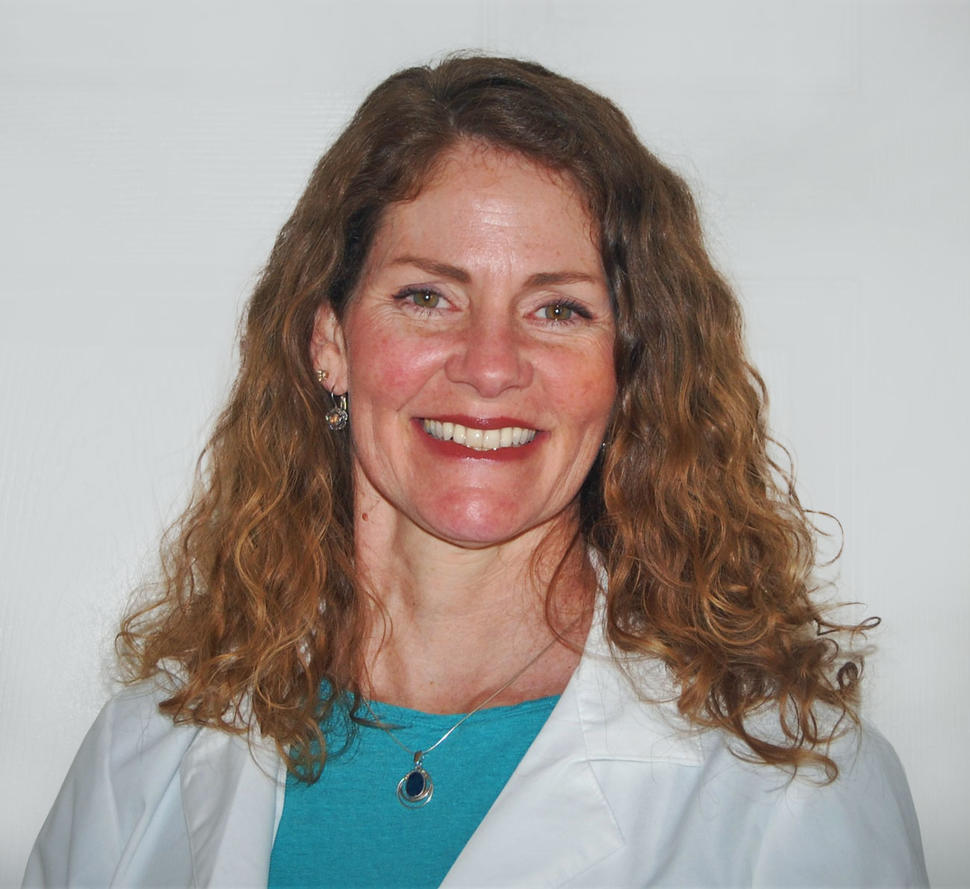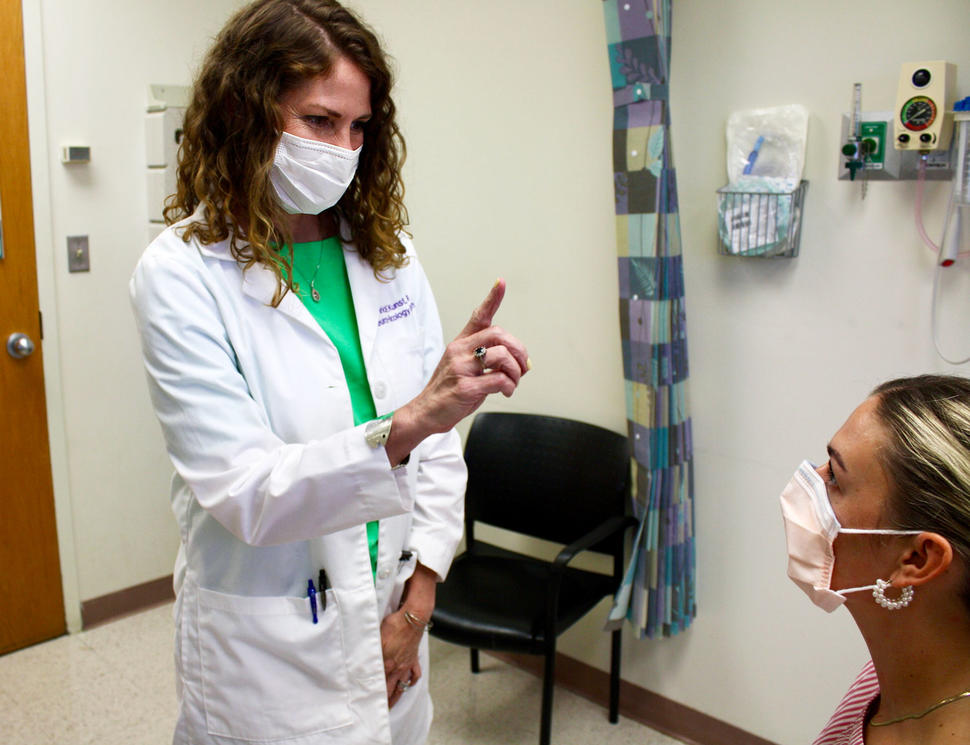Research Nurse Offers Help, Hope, and a Friendly Voice to People with Rare Brain and Spine Tumors
, by Kendall Morgan, NCI-CONNECT Contributor
Research Nurse Tricia Kunst joined the Neuro-Oncology Branch in February 2022 after 21 years in the Thoracic Surgery Branch. She shares what she loves most about her job and the people she gets to meet along the way.
Neuro-Oncology Research Nurse Tricia Kunst meets almost every single new patient visiting the NCI-CONNECT Clinic at NIH, even before they set foot on campus. That’s because she is the friendly voice on the other end of the line who provides background information to those interested in participating in the flagship Natural History Study. Led by the NCI Center for Cancer Research’s Neuro-Oncology Branch (NOB), this observational study collects information and data from patients to track their disease over time.
“We offer the Natural History Study to all of our adult neuro-oncology patients, hoping all of them will participate,” Kunst says. “Currently, we have over 1,000 patients who have enrolled.”
The goal of the study is to learn as much as possible about brain and spine tumors by studying those living with these rare cancers. The study also connects people with brain and spine tumors to a team of doctors and others who can help them manage their illness and offer possible new treatment options, including clinical trial opportunities. Kunst says one of her favorite aspects of her job as a research nurse in the Natural History Study is meeting so many remarkable people.
“I personally like being able to meet the new patients—whether by phone or in person—and hear about their stories. I find that people are always so grateful for an opportunity to come to NIH. When I get to meet some of the patients in person during their clinic visit it’s an extra bonus, and it’s always nice putting a face with a name.”
“Tricia is a skilled research nurse who goes above and beyond,” says Terri Armstrong, Ph.D., the NOB’s deputy chief and co-leader of NCI-CONNECT. “I am so grateful to have her as a partner in the Natural History Study. She is an incredibly kind and compassionate person who touches everyone she cares for.”
Finding Inspiration
When she first became a nurse in 1995, Kunst hadn’t expected to pursue a career in research as well. But after working for a few years in her hometown of Annapolis, Maryland, she started to think she might want to broaden her horizons. She remembered a field trip to NIH she took in nursing school.
“Even though I’m from Maryland and NIH was basically in my backyard, going there for the first time was like Disney World,” she says. “I was in awe.”
She decided that working as a research nurse at NIH would be the best job for her. Fast forward to today, and she’s been at NIH for over two decades. Most of that time she spent in the Thoracic Surgery Branch, before joining the NOB in February 2022.
Tricia is a skilled research nurse who goes above and beyond. She is an incredibly kind and compassionate person who touches everyone she cares for.
In all those years as research nurse in thoracic surgery, Tricia fulfilled a role similar to her current one: handling clinical trials and serving as a first contact for patients. What impresses her most about the NOB is its sheer size and the expertise of the clinicians, along with the benefits the Branch offers for people facing rare and hard-to-treat cancers.
“I was really very impressed with the size of the neuro-oncology group,” she says. “I wanted to be part of a big team and I love that aspect. I’ve learned a lot more being able to have a working relationship with other research nurses on the same team. Our NOB team is also able to collaborate with so many other providers nationwide and internationally—it’s a great benefit to patients to have so many experts weigh in on their cases.”
Day in the Life
When people first come to the NCI-CONNECT Clinic, they’ll meet Kunst or one of three other research nurses on staff, depending on the day. For Kunst, it’s one of the highlights of the job.
Most of the patients she speaks to are new to NIH, although sometimes they may be referred from another branch. Kunst typically reaches out to see if new or newly referred patients participating in NIH clinical trials would also like to participate in the Natural History Study. She’ll take time to introduce the mission of the study. She covers the various participation requirements and answers any questions. For those who decide to sign up, she also handles the consent process, which can be done remotely through text or email. Next, she informs the team a new patient has been enrolled, so they can work on getting all the paperwork, pathology, and other medical records in order.
“When I meet somebody in clinic after we’ve talked on the phone, we’re all so happy,” she says. “They want to be there; they’re grateful. Usually there are not a whole lot of questions. It’s a more of a social conversation, but I think patients need that and nurses need it, too. This connection makes it feel like we are all a big family working together to combat their disease.”
What to Expect
After the first visit, the plan for each person will vary depending on their clinical needs. Natural History Study participants come back to NIH at least once a year, if not more, depending on how often they’ll need to get brain or spine tumor imaging or scans on site. In some cases, participants can have scans done locally and sent to NIH.
Once enrolled, all participants are sent links to a thorough baseline questionnaire and a second symptom questionnaire by email. Participants are given the symptom questionnaire to answer again at each subsequent visit. The smart survey questionnaires aim to capture what people with brain and spine tumors are experiencing, in terms of symptoms and general well-being. Smart surveys track answers and adjust future questions accordingly to ensure their relevance.
The answers to those questions aren’t just recorded—they are also put into action, Kunst says. If providers see any changes in a patient’s symptoms based on their answers, they can look for the causes and determine ways to make improvements as needed.
“Patients essentially get focused, individual plans of care, which helps improve their quality of life,” Kunst says. “It also gives providers other general information about patients with these rare tumors, in hopes of improving quality of life for the patient community more broadly.”
A Second Layer of Care
If Kunst could reach out to each and every person with a rare brain or spine tumor, “I would tell them to contact NIH because it’s a huge benefit to have this awesome group looking at your scans, current diagnosis, and treatment options,” she says.
While all NIH patients have a local doctor outside of the NIH as well, Kunst says NCI-CONNECT acts as a “second layer of care.”
“There might be other treatment options available,” she says. “Or, further down the road, if your current standard of care treatment stops working, there could be a clinical trial to help—and luckily, you’re already in the door. It’s a huge benefit to have more than one institute or clinical care team looking out for you.”

